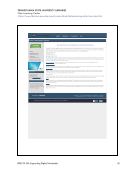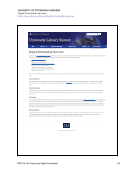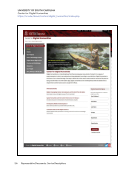10 Survey Results: Executive Summary
Digital Scholarship Activity Assessment
Almost half of the survey respondents (49%) have evaluated or assessed their digital scholarship support
activities, with more than a third (37%) planning to do so (Q26). Current efforts include documenting
the number of projects supported, which activities were involved, how many faculty members, students,
and departments engaged, and specific outreach and teaching activities completed. Beyond these
measures, plans to assess DS support will include qualitative researcher interviews, faculty surveys,
focus groups, quantitative tracking of consultations (number and time engaged), and user satisfaction
surveys (Q27). Some institutions are looking to collaborate on assessment and evaluation practices with
other ARL institutions, while others look to use data gathered to project the demand for support and
its peaks and troughs over the course of the academic year. More than half of respondents (65%) have
used their assessments to alter the services they offer, change their organizational structure, or shift
staff responsibilities (Q29). Requests from faculty and students have become part of strategic planning,
including identifying skill and role gaps (GIS and data support), the need to better coordinate requests
and support (digital scholarship coordinator roles), or to alter and add new training opportunities for
library staff, faculty, and students.
The Future Role of Library Support for Digital Scholarship
Although some respondents have reservations about the reliance on soft funding to begin projects (and in
some instances DS centers and other units), and several reported specific concerns regarding scalability,
the overall view of the future for library support of digital scholarship is strong and even enthusiastic
in many cases. The majority of respondents (64) offered some view of this future most only briefly
sketched out an idea or two along the lines of greater collaboration with researchers and students, as
part of offering a greater range of tools and services, or as the renewed center of research and scholarly
dissemination. Several specifics are echoed in numerous comments, with the essential message being
that the library operate as the center of research and dissemination, becoming the first point of contact
in the research cycle and a source of full life-cycle and long-term collaboration. Some expect to develop
this work and relationship more slowly, after greater periods of assessment and analysis, while gearing
up to meet the increasing requests and demand for GIS and digital mapping, research data management,
and becoming a more stable base for the stewardship and preservation of digital projects and research
products. Others see a more immediate need to expand and support digital library development, make
special collections more accessible beyond the campus and to the public and other interested parties. Still
others see increasing the technological sophistication of the library and its staff to help define and create
more suitable systems of storage and discovery, to better incorporate digital tools and methods not just
earlier in the research process, but as partners with faculty to integrate them into the training process for
graduate students and teaching of undergraduates. Visions include becoming the hub for future research
that uses digital tools, not just “digital scholarship,” and to be an active part of regional consortia, virtual
institutes, and entities such as the Committee on Institutional Cooperation (CIC) and Digital Public
Library of America (DPLA). Also sharing research with the public as a foundational stakeholder by
better supporting public history, public scholarship, and becoming a conduit for life-long learning and
active citizen scholarship. The role of the library in many of these futures is to be the space—physical
and virtual—to become the lab of not only the humanities, but all scholarship and research that stretches
across the campus to involve multiple units and disciplines. This future is not one where the library
supports digital scholarship, but where the digital is but one set of tools, methods, and expertise that the
library affords the extended campus community to research and share scholarship.
Digital Scholarship Activity Assessment
Almost half of the survey respondents (49%) have evaluated or assessed their digital scholarship support
activities, with more than a third (37%) planning to do so (Q26). Current efforts include documenting
the number of projects supported, which activities were involved, how many faculty members, students,
and departments engaged, and specific outreach and teaching activities completed. Beyond these
measures, plans to assess DS support will include qualitative researcher interviews, faculty surveys,
focus groups, quantitative tracking of consultations (number and time engaged), and user satisfaction
surveys (Q27). Some institutions are looking to collaborate on assessment and evaluation practices with
other ARL institutions, while others look to use data gathered to project the demand for support and
its peaks and troughs over the course of the academic year. More than half of respondents (65%) have
used their assessments to alter the services they offer, change their organizational structure, or shift
staff responsibilities (Q29). Requests from faculty and students have become part of strategic planning,
including identifying skill and role gaps (GIS and data support), the need to better coordinate requests
and support (digital scholarship coordinator roles), or to alter and add new training opportunities for
library staff, faculty, and students.
The Future Role of Library Support for Digital Scholarship
Although some respondents have reservations about the reliance on soft funding to begin projects (and in
some instances DS centers and other units), and several reported specific concerns regarding scalability,
the overall view of the future for library support of digital scholarship is strong and even enthusiastic
in many cases. The majority of respondents (64) offered some view of this future most only briefly
sketched out an idea or two along the lines of greater collaboration with researchers and students, as
part of offering a greater range of tools and services, or as the renewed center of research and scholarly
dissemination. Several specifics are echoed in numerous comments, with the essential message being
that the library operate as the center of research and dissemination, becoming the first point of contact
in the research cycle and a source of full life-cycle and long-term collaboration. Some expect to develop
this work and relationship more slowly, after greater periods of assessment and analysis, while gearing
up to meet the increasing requests and demand for GIS and digital mapping, research data management,
and becoming a more stable base for the stewardship and preservation of digital projects and research
products. Others see a more immediate need to expand and support digital library development, make
special collections more accessible beyond the campus and to the public and other interested parties. Still
others see increasing the technological sophistication of the library and its staff to help define and create
more suitable systems of storage and discovery, to better incorporate digital tools and methods not just
earlier in the research process, but as partners with faculty to integrate them into the training process for
graduate students and teaching of undergraduates. Visions include becoming the hub for future research
that uses digital tools, not just “digital scholarship,” and to be an active part of regional consortia, virtual
institutes, and entities such as the Committee on Institutional Cooperation (CIC) and Digital Public
Library of America (DPLA). Also sharing research with the public as a foundational stakeholder by
better supporting public history, public scholarship, and becoming a conduit for life-long learning and
active citizen scholarship. The role of the library in many of these futures is to be the space—physical
and virtual—to become the lab of not only the humanities, but all scholarship and research that stretches
across the campus to involve multiple units and disciplines. This future is not one where the library
supports digital scholarship, but where the digital is but one set of tools, methods, and expertise that the
library affords the extended campus community to research and share scholarship.




















































































































































































































